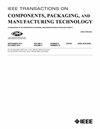Analytical and Optimal Strategy of Dynamic Current Balancing for Paralleled SiC MOSFETs With Cu-Clip Interconnection Considering Mutual Coupled Inductances
IF 3
3区 工程技术
Q2 ENGINEERING, ELECTRICAL & ELECTRONIC
IEEE Transactions on Components, Packaging and Manufacturing Technology
Pub Date : 2025-04-16
DOI:10.1109/TCPMT.2025.3561273
引用次数: 0
Abstract
To enhance the electrical performance and reliability of silicon carbide (SiC) power modules, the study explores Cu-clip as a promising alternative to traditional Al-wire interconnections. SiC power modules, particularly in parallel configurations, encounter challenges in optimizing dynamic current-sharing performance, which limits their maximum current capacity and reliability during switching events. This study proposes an innovative layout design for SiC MOSFET modules, utilizing a coupled parasitic inductance network model to capture better the impact of mutual inductances on dynamic current imbalance. The model derives an equation for equivalent source inductances, accounting for both self-inductance and mutual inductance, providing a foundation for optimizing the layout to minimize dynamic current imbalance. Based on this model, a new Cu-clip structure is designed along with a mathematical analysis aimed at reducing disparities in equivalent source inductances, thereby enhancing dynamic current balancing. The distance between the dies is also increased to mitigate thermal coupling effects. Double-pulse tests and simulations were performed to validate the dynamic current balancing performance of the fabricated power module. The results show a 40% reduction in dynamic current imbalance for the optimized layout (layout B) compared to the baseline configuration (layout A). This work presents a comprehensive solution to improve the dynamic current performance of paralleled SiC MOSFET power modules, offering significant contributions to the design of more efficient and reliable power electronics.考虑互耦电感的并联SiC mosfet铜夹互连动态电流平衡分析及优化策略
为了提高碳化硅(SiC)电源模块的电气性能和可靠性,该研究探索了铜夹作为传统铝线互连的有前途的替代品。SiC功率模块,特别是并联配置时,在优化动态电流共享性能方面遇到了挑战,这限制了它们在开关事件中的最大电流容量和可靠性。本研究提出一种创新的SiC MOSFET模块布局设计,利用耦合寄生电感网络模型更好地捕捉互感对动态电流不平衡的影响。该模型导出了考虑自感和互感的等效源电感方程,为优化布局以减小动态电流不平衡提供了基础。基于该模型,设计了一种新的铜夹结构,并进行了数学分析,旨在减小等效源电感的差异,从而增强动态电流平衡。模具之间的距离也增加,以减轻热耦合效应。通过双脉冲实验和仿真验证了该功率模块的动态电流平衡性能。结果表明,与基线配置(布局a)相比,优化布局(布局B)的动态电流不平衡降低了40%。这项工作提出了一个全面的解决方案,以改善并联SiC MOSFET功率模块的动态电流性能,为设计更高效、更可靠的电力电子产品做出了重大贡献。
本文章由计算机程序翻译,如有差异,请以英文原文为准。
求助全文
约1分钟内获得全文
求助全文
来源期刊

IEEE Transactions on Components, Packaging and Manufacturing Technology
ENGINEERING, MANUFACTURING-ENGINEERING, ELECTRICAL & ELECTRONIC
CiteScore
4.70
自引率
13.60%
发文量
203
审稿时长
3 months
期刊介绍:
IEEE Transactions on Components, Packaging, and Manufacturing Technology publishes research and application articles on modeling, design, building blocks, technical infrastructure, and analysis underpinning electronic, photonic and MEMS packaging, in addition to new developments in passive components, electrical contacts and connectors, thermal management, and device reliability; as well as the manufacture of electronics parts and assemblies, with broad coverage of design, factory modeling, assembly methods, quality, product robustness, and design-for-environment.
 求助内容:
求助内容: 应助结果提醒方式:
应助结果提醒方式:


